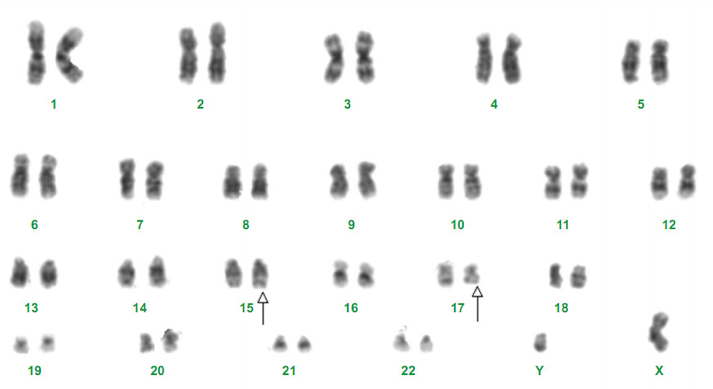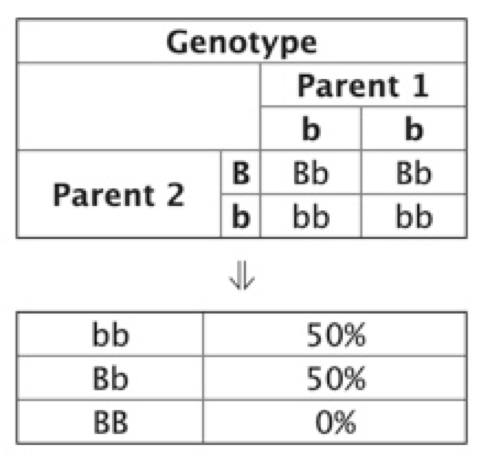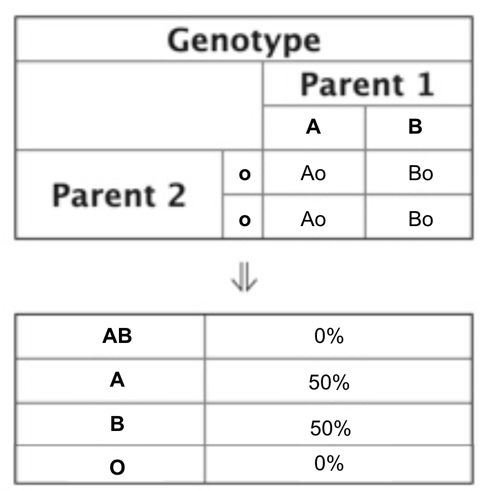Punnett squares
Learning Objectives
Vocab:
- Punnett square
- Monohybrid cross
- Gene
- Allele
- Dominant alleles
- Recessive alleles
- Homozygous
- Heterozygous
A Punnett square is a grid formed by 4 squares to form a larger square. Scientists use this as a way to predict a trait or genotype that comes from two different people or organisms. Before talking about how to use a Punnett square, the next important topic is alleles and the different types of alleles.

Each human cell has 23 pairs of chromosomes and each chromosome consists of hundreds of thousands of different genes. Genes are used to pass traits from parent to offspring. An allele is a pair of genes on a chromosome that determine a hereditary trait.
With alleles, there are two main types of alleles that are essential. A dominant allele is one that will be more overpowering than another allele and a recessive allele is an allele that can be overpowered by a dominant allele. Dominant alleles are represented by capital letters and recessive alleles are represented by lowercase letters. For example, blue eyes are a recessive trait and brown eyes are a dominant trait. Therefore, if a female has blue eyes they can be represented by “bb” and if a male has brown eyes this can be represented as “BB” or “Bb”. The reason why brown eyes can be represented as “Bb” is that the capital “B” is dominant over the lowercase “b”. For the example, assume that the male has the “Bb”.
A monohybrid cross is a cross between two organisms with different variations of one trait. A Punnet square is a monohybrid cross and is going to be used to compare the traits of the example given earlier.
For traits that have either two capital letters or two lowercase letters are known as a homozygous trait and for traits that have alternating letters are known as heterozygous traits. In heterozygous alleles, the capital letter will always come first.
To begin, write the two letters of the blue-eyed female on top and the two letters of the brown brown-eyed male on the side. Next, we’re just going to match the letters down each square and look at the possible outcomes if they had offspring.

As you can see there is a 50% chance that the homozygous recessive trait of blue eyes will be shown on their next kid, a 50% chance that the heterozygous dominant trait of brown eyes is given on the next offspring, and a 0% chance of a homozygous dominant trait given to the offspring.
In some cases, there are two dominant alleles that are present and causes no blending. For example, if a flower had the dominant allele of Red and the dominant allele of White the flower petals will show spots of red and white. This is called co-dominance. In the case of incomplete dominance, the flower would blend the two colors to form a pink petals.
Another example where we can use a punnett square is with blood types. Let’s say a female has a blood type of AB and a male has the blood type of O. Both A and B are considered co-dominant meaning that both the A and the B are present on the females blood cells. The O blood type is a recessive allele and for the punnett square it will be written as “oo”. Here is a list of genotypes for each blood type.
| Blood Type | Genotype |
| A | AA or Ao |
| B | BB or Bo |
| AB | AB |
| O | oo |
Let’s try to draw a punnett square with the AB female and the O male. First we always begin by drawing the punnett square and writing the genotypes on the top and side. For our example, I will write the female on top and the male on the side.
Next, we will match the letters for each box on the punnett square.

As you can see from the punnett square, the offspring of these two people would have a 50% chance of the blood type A and a 50% chance of the blood type B. In this case, both of these blood types would be heterozygous because the genotypes consist of the o allele.
Figure 2 Image Credit: “Genotype” by Annie Chen
Figure 3 Image Credit: “Genotype2” by Annie Chen
a 2 x 2 grid that guides predictions of gene inheritance
long strands of DNA carrying many genes; basic unit of inheritance.
section of chromosome that codes for a single protein or nucleic acid that can be synthesized by a cell
a specific variant of a gene
version of gene that will be expressed any time it is present
version of a gene that will only be expressed if there is not a dominant allele present on a different copy of the chromosome
the simplest gene-inheritance scenario
both inherited alleles are identical
inhereted alleles do not match

